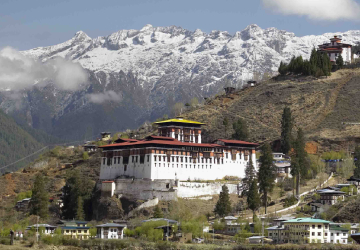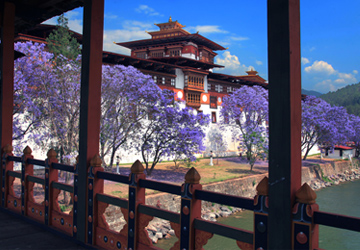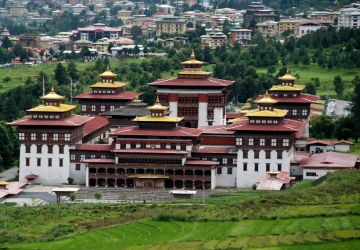Day 01
Arrival Kolkata by late night flight
- Meeting and assistance on arrival transfer hotel- close to the airport.
- Overnight at the hotel.
Day 02
Bagdogra by flight 6E 503 @ 1030/ 1145 hrs and Bagdogra/ Gangtok (125 kms / 05 hrs)
- Breakfast at the hotel
- After breakfast in time transfer to the airport to connect flight for Bagdogra. Meeting and assistance upon arrival and drive towards- Gangtok- via Siliguri.
Lunch at Hotel Sarovar or Marina in Siliguri
- After lunch proceed for Gangtok a panoramic drive of around 125 kms/ 5 hour- Gangtok is at an altitude of 1750m. It became the state capital in the mid19th century and has undergone rapid development since then. The downtown area is dominated by huge government buildings decorated with traditional Buddhist symbols. Gangtok is also a resting ground for people traveling to North Sikkim. Surrounded by Monasteries and Orchids, Gangtok is truly a traveler delight.
Dinner and overnight at the hotel
Day 03
In Gangtok
- Breakfast at the hotel
- Full day city tour of Gangtok- Visit of Rumtek Monastery-24 Kms. from Gangtok is the awe -inspiring Rumtek Monastery, the world Dharma chakra Centre and the seat of His Holiness, the Gyalwa Karmapa, who is the head of the Kagyupa order of Tibetan Buddhism. Behind the main monastery is the lavishly decorated Karmae Nalanda Institute of Buddhist Studies, which attracts students from the world over. Opposite the entrance to the Institute is a small hall featuring a beautiful jewel studded Chorten the Golden Stupa, which contains the ashes and remains of His Holiness the xvi Gyalwa Karmapa. According to legend, it is believed that after years of meditation, the first Karmapa was said to have been visited by ten thousand fairies who came to congratulate him each of whom offered a strand of her hair as a gift. These were said to have been woven into a black hat, which was passed down and is still at the Rumtek Monastery today. It is said that unless held on to by the wearer (who of course, cannot be anyone else but the Karmapa) or kept in a box, the hat would fly away
- Later visit of the Enchey Monastery-perched on a ridge above Gangtok, the Enchey Monastery is nestled within lush woods with a spectacular view of Gangtok town. Built in 1910 on the site of the hermitage of the great tantric saint, Lama Drutob Karpo, who was renowned for his powers of levitation, this monastery houses the monks of the Nyingmapa Order of Tibetan Buddhism.
- Lunch at the hotel
- Afternoon visit of Namgyal Institute of Tibetology-amidst a serene surrounding of oak, birch and ash lies the unique organization established in1958. Built in traditional style, the namgyal Institute of Tibetology promotes research in Mahayana Buddhism and the language and tradition of Tibet. It has one of the world’s largest collections of rare books and manuscripts on Mahayana Buddhism. The Institute also has a retail outlet where related books and commercially produced religious art and craft of Tibet can be bought. Adjacent to the institute are two exquisite stupas, the Do Drul Chorten, built to commemorate the victory of good over evil and the Jhang Chub Chorten, built in the memory of Thrukshik Rinpoche, an ardent devotee, a great spirtualist and interpreter of Buddhism. Near the Chorten are housed two giant statues of Lord Buddha and Guru Padmasambhava, also known as Guru Rimpoche, the patron saint of Sikkim.
- Time permitting visit of directorate of Handloom and handicrafts-this Directorate was set up to promote traditional Sikkimese art and handicrafts. Exquisitely carved wooden friezes, intricate bamboo work, along with beautiful hand woven carpets and handlooms are on exhibit here. Visitors can not only purchase these items here but also see the artisans at work. Among others, a favourite item here is the choktse a wooden table with carved panels that can be folded into a portable pack.
Dinner and overnight at hotel.

Day 04
Gangtok/ Darjeeling (98 kms 4 hour approximately)
- Breakfast at the hotel
- Morning proceed by surface for Darjeeling-standing high in the Himalayas at an altitude of 2134m, Darjeeling or ‘Dorje Ling’, or place of the Thunderbolt, offers breathtaking views of snow-capped mountain peaks, with the Kanchendzonga rising higher than all the others. Often referred to as the “Queen of the Hills”, it remains just as alluring with its tiny waterfalls, little villages and a narrow gauge railway track. Surrounded by World Famous Tea Gardens and snowcapped mountains, Darjeeling remains one of the most exotic destinations. Graeme Westlake in his book ‘An introduction to hill stations on India’ refers to Darjeeling as having “A view scarcely unrivalled on Earth”.
- Lunch at the hotel
- Afternoon visit of Himalayan Mountaineering Institute/ Padmaja Naidu Himalayan Zoological Park- The Himalayan Mountaineering Institute was started in Darjeeling when Tenzing Norgay climbed Everest to give training to learn mountaineering and other adventure sports related to mountaineering and in that Institute one can see equipment etc. used by Mr. Tenzing Norgay and Everest Museum having complete details on Everest attached to institute one can visit Himalayan Zoological Park where one can see Himalayan animals like Snow Leopard, Tibetan Wolf, Tibetan Yak, Himalayan Black Bear and several varieties of birds.
- Later visit of Tibetan self-help center Or Refugee Centre-this institute is run by Tibetan Refugees to preserve their handicrafts and one can see making of Tibetan Carpets, Leather work, Paintings and Wooden work etc.
Dinner and overnight at Hotel
Day 05
In Darjeeling
- Tea/ Coffee at the hotel and an early morning visit Tiger Hill and Ghoom Monastery.
- Tiger Hill-it is around 13 kms from Darjeeling and one can see beautiful sunrise and Himalayan Range like Kanchandzonga, Mount Everest etc. One can see the horizon changing colors just before sunrise and then the entire Himalayan range turn golden. It is truly a majestic sight.
- On return visit of Ghoom Monastery-this is oldest Monastery in the area which was built in 1875 and one can see the image of Mythey Buddha 15ft. height on the way back from Tiger Hill
- On return breakfast at the hotel
- Later in the morning enjoy toy train ride- Toy Train- the spectacular landscape unfolds as the 2-foot gauge Darjeeling Himalayan railway, opened in 1881, labours at about 10 mph criss-crossing the road. It has tiny 4-wheel locomotives (some over 100 years old) like living legends. One can experience the sound, smell and romance of a bygone era. DHR or Darjeeling Himalayan Railways is a work of genius and technological achievement of 1881. It has social and cultural importance. It is beautiful and has outstanding universal appeal. Based on its unique features, it is considered to be of lasting significance to mankind.
- Late lunch at the hotel
- Rest of the day at leisure and to enjoy some shopping in the local market and enjoy amenities/ facilities available at the hotel
Dinner and overnight at the hotel.

Day 06
Darjeeling/ Phuntsoling (197 kms/ 7 hours)
- Early breakfast at the hotel
- Later proceed for Phuntsoling the entry to the Kingdom of Bhutan- arrive at Phuntsoling and check in at the hotel
- Late lunch at the hotel
- Rest of the day at leisure and complete the formalities of getting the necessary permit to visit the various areas of Bhutan and endorsement on the VISA. All these shall be completed by the representative in Bhutan.
- Time permitting panoramic tour of Phuntsoling
Dinner and overnight at the hotel

Day 07
Phuntsoling/ Thimpu (180 Kms/ 6 Hours approximately)
- Breakfast at the hotel
- Morning proceed by surface for Thimpu- a panoramic drive through the serpentine roads. Midway stopovers en route
- Arrive at Thimpu-the capital of Bhutan and check in at the hotel
- Late lunch at the hotel of stay or at local restaurant (if staying at standard hotels in Bhutan)
- Afternoon visit of National Library, which holds a vast collection of ancient Buddhist texts and manuscripts, some dating back several hundred years, as well as modern academic books mainly on Himalayan culture and religion.
- Also visit nearby Institute for Zorig Chusum: commonly known as Arts & Crafts School or Painting School, the Institute offers a six-year course on the 13 traditional arts and crafts of Bhutan. On a visit, one can see students learning the various skills taught at the school. Later drive towards city center to visit Textile and Folk Heritage Museum: These museums, both of which opened in 2001, provide fascinating insights into Bhutanese material culture and way of life. Conclude sightseeing with a visit of Trashichhodzong-this impressive fortress/ monastery houses secretariat building, the throne room of His Majesty, the King and various government offices. It is also the summer residence of Chief Abbot and central monk body.
Dinner and overnight at the hotel.

Day 08
Thimpu/ Punakha (75 kms/ 3 Hours)
- Breakfast at the hotel
- After breakfast, drive up to Dochu-la pass (3,088m/ 10,130 ft) stopping briefly here to take in the view and admire the chorten, mani wall, and prayer flags which decorate the highest point on the road. If skies are clear, the following peaks can be seen from this pass (left to right): Masagang (7,158m), Tsendagang (6,960m), Terigang (7,060m ), Jejegangphugang (7,158 m ), Kangphugang (7,170 m ), Zongphugang (7, 060 m ), a table mountain that dominates the isolated region of Lunana – finally Gangkar puensum, the highest peak in Bhutan at 7,497m.
- Arrive Punakha and check in at the hotel
- Late morning proceed to visit Punakha Dzong, a massive structure built at the junction of two rivers. It was the capital of Bhutan until 1955, and still serves as the winter residence of the monk body. The first King, Ugyen Wangchuck was crowned here in 1907. The fortress has withstood several damages from fire, earthquake and flood. The latest flood of Oct’ 1994 caused great damages to the fortress but miraculously spared the statue of Buddha Jojampa.
- Lunch at the hotel of stay or at local restaurant (if staying at standard hotels in Bhutan)
- Afternoon take a short and easy hike to Chimi Lhakhang, situated on a hillock in the center of the valley, is dedicated to Lama Drukpa Kuenley, who in the late 15th century used humour, songs and outrageous behaviour to dramatize his teachings and due to this also known as ‘Divine Madman’. This temple is also known as the temple of fertility. It is widely believed that couples who do not have children and wanting one, if they pray at this temple, they are usually blessed with a child very soon. It is about 30 minute walk across field from the road to the temple. The trail leads across rice fields to the tiny settlement of Pana, meaning ‘field’. It then follows a tiny stream downhill to Yoaka and across more fields before making a short climb to Chimi Lhakhang.
- Evening can be spent exploring Punakha village located right on the bank of river.
Dinner and overnight at the hotel.

Day 09
Punakha/ Paro (125 kms/ 4 Hours)
- Breakfast at the hotel
- Morning proceed for Paro- descending back down from Dochu La, follow the way back up the dramatic Wang Chhu and Paro Chhu river valleys, before crossing through Paro Town towards the north end of the valley. Upon arrival check in at the Hotel
- Lunch at the hotel of stay or at local restaurant (if staying at standard hotels in Bhutan)
- Later proceed for the visit of Ta Dzong (Sun & Mon closed)-once a watchtower, built to defend Rinpung Dzong during inter-valley wars of the 17th century, Ta Dzong was inaugurated as Bhutan’s National Museum in 1968. It holds fascinating collection of art, relics, religious thangkha paintings and Bhutan’s exquisite postage stamps. The museum circular shape augments its varied collection displayed over several floors Afterwards, walk down a hillside trail to visit Rinpung Dzong, which has a long and fascinating history. Built in 1646 by Shabdrung Ngawang Namgyal, the first spiritual and temporal ruler of Bhutan, the Dzong houses the monastic body of Paro, the office of the Dzongda (district administrative head) and Thrimpon (judge) of Paro district. The approach to the Dzong is through a traditional covered bridge called Nemi Zam. A walk through the bridge, over a stone inlaid path, offers a good view of the architectural wonder of the Dzong as well as life around it. It is also the venue of Paro Tshechu, held once a year in the spring.
Dinner and overnight at the hotel

Day 10
In Paro
- Breakfast at the hotel
- Morning proceed for an excursion to Taktshang Monastery also popularly called Tiger’s nest (5hrs hike)- it is one of the most famous of Bhutan’s monasteries, perched on the side of a cliff 900m above the Paro valley floor. It is said that Guru Rinpoche arrived here on the back of a tigress and meditated at this monastery and hence it is called ‘Tiger’s Nest’. This site has been recognised as a most sacred place and visited by Shabdrung Ngawang Namgyal in 1646 and now visited by all Bhutanese at least once in their lifetime. On 19th April, 1998, a fire severely damaged the main structure of building but now this Bhutanese jewel has been restored to its original splendour.
- Lunch at the restaurant
- On the way back into town visit Drukgyel Dzong- this Dzong, with a delightful village nestling at its foot, was built in 1646 by Shabdrung Ngawang Namgyal to commemorate his victory over the Tibetan invaders. Historically and strategically this Dzong withstood all its glory and was featured in 1914 vide National Geographic magazine. The glory of Drukgyel Dzong remained even when it was destroyed by fire in 1951. On a clear day, one can see the commanding view of Mount. Chomolhari from the village, below the Dzong.
- Drive a little further down the dzong to visit Kyichu Lakhang- it is one of the oldest and most sacred shrines of the Kingdom dating back to 7th century (the other is Jambey Lhakahng in Bumthang). The lhakhang complex is composed of two temples. The first temple was built by Tibetan King, Songtsen Gampo in the 7th century and in 1968, H.M. Ashi Kesang, the Queen Mother of Bhutan, built the second temple in same original pattern.
Dinner and overnight at the hotel

Day 11
Paro/ Kolkata by KB 401 at 0925/ 1040 hours
- Breakfast at the hotel
- Later in time transfer to the airport to connect flight for Kolkata
- Meeting and assistance on arrival transfer hotel
- Rooms foreseen from 12 Noon onwards on this day
- Lunch at the hotel
- Afternoon visit Dalhousie Square (commercial area) also known as BBD Bagh This is the site of all the important government institutions of the state This is the place that houses the now famous Writer’s Building (clerks were known as writers in the British India). Visit St. John’s Church Drive past Raj Bhavan (the residence of the Governor of West Bengal), High Court, Legislative Assembly Afternoon the “Belur Math”- the head-quarters of Ram Krishna Mission Drive over the busy Howrah Bridge in order to reach the “Belur Math” The “Math” is outside city (approximately 16 Kms) Later visit the Dakhsineshwar Temple and evening return to hotel
Dinner and overnight at the hotel

Day 12
In Kolkata
- Early morning visit to fruit and flower market and nearby visit the Kumartali where the idols of the religious/ mythological gods are made
- On return breakfast at the hotel
- Morning proceed on to visit the Gurusaday Museum, Marble Palace, and the Indian Museum (closed on Mondays) which houses some priceless treasures of ancient civilizations and an excellent art gallery and later visit the Chowrangee where the people of Kolkata do shopping.
- Rooms foreseen till 12 Noon on this day
- Lunch at the hotel
- Afternoon city tour of Kolkata visit Victoria Memorial (closed on Mondays) an imposing marble edifice, the picture-postcard symbol of Kolkata. It stands serene and unmindful of the bustling commercial quarter nearby, a tribute to Queen Victoria Inside are the memorabilia of the British Empire Also visit the Cathedral of St. Paul’s
- Dinner at the hotel
- After dinner in time transfer to the airport to connect flight for onward journey. Flight check in starts three hours before the schedule departure time. Assistance provided for flight check in










